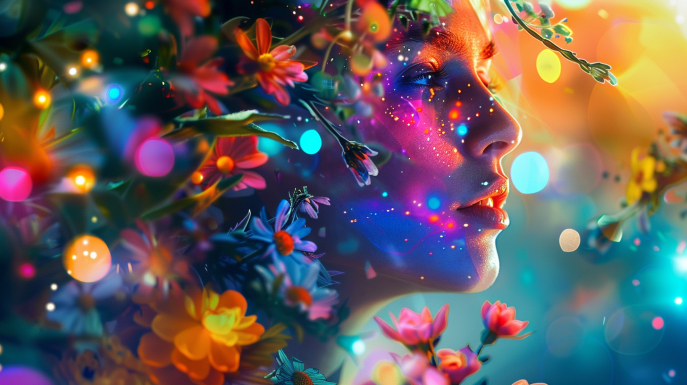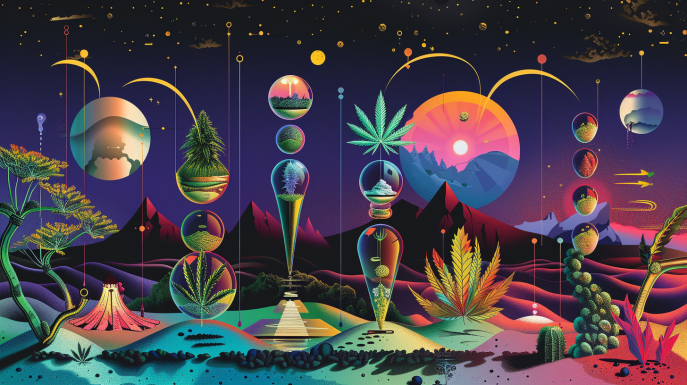Ever wondered what it feels like to be high or stoned? As cannabis gains more and more popularity, and with its legalization in several countries and states, an increasing number of individuals are keen to understand the effects of cannabis consumption.
This blog post aims to dissect the different facets of the cannabis experience, clarify the terms ‘high’ and ‘stoned’, and delve into how the two primary types of cannabis – Indica and Sativa – can influence the intoxication experience. So, let’s embark on this exploration of the cannabis high together!
What does being high feel like?
Being high is often associated with the cannabis experience. When you’re high, you could feel a range of sensations that boost your well-being and alter your perception. Some potential effects include:
- Euphoria and happiness: When high, many people report feeling an intense sense of joy and satisfaction. This sensation can lead to seeing life from a more positive perspective and feeling overall happier.
- Enhanced creativity: An increased level of creativity is another effect of being high. You might find yourself flooded with new ideas and thoughts, feeling the urge to express these creative impulses – whether through painting, writing, making music or other artistic activities.
- Heightened sensory perception: Your senses may be heightened when you’re high. Colours could seem more vibrant, smells and tastes stronger, and sounds more impressive.
- Relaxation: Many people experience deep physical and mental relaxation when they’re high. Tensions and stress may ease, leading to a sense of calmness and tranquility.
- Sociability and talkativeness: Another aspect of being high is becoming more talkative and open. You might feel the need to interact with others, sharing your thoughts and feelings.
The feeling of being high is caused by the cannabinoid THC (Tetrahydrocannabinol) binding to the CB1 receptors in your brain, triggering the typical psychoactive effects.

What does being stoned feel like?
Unlike being high, being stoned focuses more on physical sensations. When you’re stoned, you might experience the following sensations that have more of a bodily impact:
- Intense physical relaxation: The sensation of being ‘stoned’ primarily features profound physical relaxation. Your muscles might loosen up, and you may feel like lying down or just sitting still to enjoy the relaxation.
- A sense of heaviness and sluggishness: When you’re stoned, you might feel heavy and sluggish. Your movements may be slower and less coordinated, and you might feel as if your limbs are made of lead.
- Increased pain tolerance: Another effect of being stoned is enhanced pain tolerance. Many people use cannabis to alleviate pain as it can decrease pain perception, contributing to discomfort relief.
- Drowsiness: Being stoned often induces relaxation, potentially leading to drowsiness. You may want to take a nap or just sit still and enjoy the relaxation.
- Increased appetite: Another known phenomenon when stoned is the so-called ‘munchies’ – an increased appetite. You might suddenly crave certain foods and feel the need to eat large amounts.
The feeling of being stoned also results from the effects of THC, but other cannabinoids and terpenes can also play a role in influencing the intoxication experience.
Navigating the Different Levels of a Cannabis High
As we embark on the journey through the stages of a cannabis high, it’s important to keep in mind that the intensity and duration can vary depending on the method of consumption, whether it be smoking, vaping, or taking edibles. Let’s dive in!
Stage 1: The Lift-Off – Initial Signs of Influence
After your first hit, nibble, or puff of cannabis, the active compounds, especially THC (Tetrahydrocannabinol), start to work their magic.
The lift-off can arrive within a few minutes with smoking or vaping but might take up to an hour or more when ingesting edibles.
During this stage, you may notice the first subtle shifts in your consciousness and perception. A sensation of lightness may wash over you as if a weight has been lifted off your shoulders.
You may find your spirits lifting, and an unexpected wave of euphoria might hit you. Colors might seem more vibrant, sounds might become more pronounced, and flavors may taste richer than usual.
Stage 2: The High – A Burst of Creativity and Enhanced Sensory Perception
Once lift-off has been achieved, you transition into the high stage. This is when cannabis’ influence is at its peak. Here’s what you might experience:
- Your thoughts might race freely, leading to a surge of creativity. You might stumble upon fresh insights and form unique connections between different concepts.
- Your sensory perception could intensify even more where colors appear more vibrant, sounds are clearer and flavors are robust.
- The sense of euphoria may amplify, leading to more laughter and a heightened sense of humor.
- You may also experience a spike in empathy and a stronger emotional connection to those around you.
Stage 3: The Transition from High to Stoned
Once the high reaches its zenith, the transition to the stoned phase begins. During this stage, the focus shifts from cognitive and creative effects to physical sensations and relaxation. Here’s what might happen:
- You might feel heavier and sluggish, as if sinking into your chair or bed. This makes it a perfect time to relax, especially if you suffer from muscle tension or pain.
- Your thoughts could slow down and become less focused. Instead of jumping from thought to thought, you might find yourself lingering over single ideas or drifting into daydreams.
- The heightened sensory perception might start to fade, bringing your sensory experiences back to normal. The relaxation could be so intense that you struggle to stay awake.
Stage 4: The Stoned Stage – Deep Relaxation and Body Awareness
In the stoned phase, physical relaxation takes center stage. You might experience:
- An intensified awareness of your body, including your breathing, heartbeat, and other physical sensations.
- Your muscles might start to loosen up and any existing pain may reduce. This is particularly beneficial if you suffer from chronic pain or other physical ailments.
- A strong urge to lay down or get comfortable to fully enjoy the relaxation. Don’t be surprised if you fall asleep during this phase. Cannabis’s relaxing effect can make one quite drowsy.

Stage 5: The Afterglow – Gentle Waning of Effects
Once the stoned phase peaks, the effects of cannabis start to gently wane. This stage is characterized by a soft afterglow:
- The feeling of relaxation might linger even as the more intense physical and mental effects fade away.
- Your mood might remain uplifted, leaving you feeling content and balanced.
- You might notice an improvement in your sleep quality once the effects completely wear off. Cannabis often has a positive impact on sleep.
Understanding the Potential Side Effects of Cannabis and How to Manage Them
Whilst partaking in cannabis can bring about a sense of relaxation and enjoyment for many, it’s essential to be aware of the potential side effects that may come into play. Let’s delve into some common side effects and share some handy tips on how to deal with them:
- Paranoia or Anxiety: It’s not uncommon for some individuals to experience feelings of anxiety or paranoia when under the influence. If you find yourself in such a situation, remember that this is a temporary state and you are in a safe environment. Deep breathing and relaxation techniques can be instrumental in reducing these feelings.
- Dry Mouth: A common side effect of cannabis is dry mouth. To counteract this, ensure you’re regularly hydrating or sucking on sugar-free candies to stimulate saliva production.
- Bloodshot Eyes: Cannabis can cause blood vessels in your eyes to expand leading to red eyes. Using eye drops can help lessen the redness.
- Dizziness or Light-headedness: Some folks may feel dizzy or light-headed when consuming cannabis. In such instances, it’s best to sit or lie down until the sensation passes.
- Excessive Intake: If you feel like you’ve overindulged, maintain your calm and remind yourself that the effects will fade with time. Try resting in a tranquil, safe environment and breathe deeply.
Conclusion: A Unique Experience
The effects of cannabis vary from person to person, influenced by multiple factors. The different stages of the high, from being “high” to “stoned”, can cause varied physical, mental, and emotional effects.
It’s critical to listen to your body and consume cannabis responsibly for the optimal experience.
If you’re considering trying cannabis, ensure you’re in a safe, comfortable environment and start with a low dose.
This approach will allow you to gauge how your body reacts and control the effects better. Remember, experiences can vary from person to person, so be open to exploring your individual sensations and reactions.
Overall, cannabis provides a fascinating array of effects, from heightened creativity and euphoria to profound relaxation and pain relief.
By respecting your personal boundaries and preferences while consuming responsibly, you can enjoy the diverse impacts of cannabis and possibly witness positive changes in your life.
Legal and Health Considerations
Before deciding to consume cannabis, do your homework on the legalities and health implications within your country. In many places, possessing and consuming cannabis is illegal, whereas other countries allow medicinal and/or recreational use.
Despite the therapeutic benefits cannabis offers many people, there are health considerations you need to keep in mind.
Long-term regular consumption could increase the risk of mental health disorders such as depression, anxiety or schizophrenia, especially for individuals with a genetic predisposition for these conditions. Also, smoking cannabis can lead to respiratory issues, much like tobacco smoking.
To minimise potential health risks, consider alternative consumption methods such as vaping, edibles or tinctures which can be less harmful to the lungs.

It’s also advisable to limit your consumption within reasonable limits and watch out for signs of dependency or negative impacts on your life.
Reading Tip: Recognising additives in weed is a crucial step to ensure a safe and enjoyable cannabis experience.
Learning how to detect Brix, hairspray and sugar in your buds can protect you from potential health risks and guarantee the quality of your weed.
Always trust your gut instinct and if in doubt, it’s better to abstain from consumption. Stay safe and enjoy responsibly!
Experiencing Cannabis Socially
Enjoying cannabis often goes hand in hand with socializing for several people.
Sharing a joint, swapping tales, and experiencing the effects of cannabis together can foster unique bonds among friends and acquaintances and offer fresh insights into life.
When you partake in cannabis with a group, ensure everyone is comfortable and acquainted with the potential outcomes.
Transparent conversation along with mutual consideration is key for guaranteeing everyone can fully appreciate the experience.
Respect others’ boundaries and preferences, and be ready to share your sensations and experiences to cultivate a positive and supportive ambiance.
The Power of Cannabis: Medical and Therapeutic Uses
Beyond recreational use, cannabis is progressively being used for medical and therapeutic purposes.
Research has indicated that cannabis can assist in alleviating a host of ailments, including chronic pain, nausea and vomiting related to chemotherapy, Multiple Sclerosis, epilepsy, and more.
Since cannabis research is ongoing, it’s worthwhile to keep abreast of new discoveries and developments.
This way, you can broaden your knowledge and potentially benefit from the therapeutic advantages of cannabis if you or someone you know suffers from a condition that could be treated with cannabis.
However, it’s essential to remember that using cannabis for medical purposes differs from recreational use and should generally be under the supervision of a doctor or medical professional.
Before considering using cannabis to alleviate symptoms or discomfort, consult your physician to determine if it’s suitable for you and what dosage and administration method best suits your situation.
Responsible Consumption and Respect for the Plant
Ultimately, the key to thoroughly enjoying the effects of cannabis lies in responsible consumption and respect for the plant.
This entails finding the appropriate dosage that works best for you, listening to your body, and respecting others’ boundaries.
Moreover, understanding the cultural and historical context of cannabis is vital, perceiving the plant as a tool for enhancing life rather than an escape from reality.
By adopting a respectful and mindful approach towards cannabis, you can tap into the plant’s full potential and foster a deeper connection with yourself and your surroundings.
In conclusion, the effects of cannabis can be a multi-layered and nuanced experience, ranging from euphoria and heightened creativity to deep relaxation and body awareness.
By acquainting yourself with various stages of high and consuming mindfully and responsibly, you can extract the most from your experience and possibly induce positive changes in your life. It’s up to you to shape the experience and navigate your journey through the world of cannabis.
Being high is associated with euphoria, creativity, and heightened sensory perception, while being stoned focuses on intense physical relaxation and heaviness.
Indica strains typically cause more of a stoned, relaxing effect, while Sativa strains are more likely to cause a high, uplifting experience.
Expect initial euphoria and creativity during the high, followed by physical relaxation and heaviness as you transition to being stoned, ending with a gentle afterglow.
Stay hydrated to combat dry mouth, use eye drops for red eyes, and sit or lie down if you feel dizzy or light-headed.
Yes, but ensure everyone is comfortable and aware of potential effects, and respect each other’s boundaries to create a positive experience.
Cannabis can help alleviate chronic pain, nausea, multiple sclerosis, epilepsy, and more, but should be used under medical supervision.









